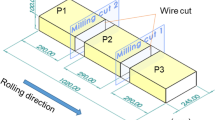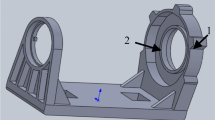Abstract
Aluminum alloy is applied in aerospace widely and prominently due to its advantages in physical and mechanical properties. The clamp method for thin-walled aluminum alloy workpiece remains an important challenge in processing field. This paper presents an optimized clamp method for thin-walled aluminum alloy rotational conical with large diameter during processing to ensure the wall thickness of the parts in various regions. Based on ANSYS, the vibration modal analysis model and the simplified cutting model are established respectively, for studying the modality and machining distortion. The influences of three clamping conditions on the most sensitive area of parts are compared. Base on the simulation analysis, the verified machining experiments of three different clamp methods are conducted. As the study subjects, the dimensional precision of wall thickness and the weight of parts are analyzed. The results show that the optimized contour support clamping condition can effectively guarantee the quality and precision of parts’ processing.

















Similar content being viewed by others
Availability of data and materials
The datasets used or analyzed during the current study are available from the corresponding author in reasonable request.
References
Nervi S (2005) A mathematical model for the estimation of the effects of residual stresses in aluminum plates. Wichita State University
Hu Q, Qiao L, Zhang H (2013) Optimization of thin-walled part milling parameters based on finite element and orthogonal dominance analysis. Chin J Mech Eng 49(21):176
Lim EM, Feng HY, Menq CH, Lin ZH (1995) The prediction of dimensional error for sculptured surface productions using the ball-end milling process. Part 1: chip geometry analysis and cutting force prediction. Int J Mach Tools Manuf 35(8):1149–1169
Liu YM, Jiang ZL, Liu WP, Li Z (2012) Rebound deformation of thin part caused by clamping force in end milling. Appl Mech Mater 217-219:1655–1658
Raghu A, Melkote SN (2004) Analysis of the effects of fixture clamping sequence on part location errors. Int J Mach Tools Manuf 44(4):373–382
Liu C, Sun J, Li Y, Li J (2018) Investigation on the milling performance of titanium alloy thin-walled part with air jet assistance. Int J Adv Manuf Technol 95(6):1–10
Wu D, Wang H, Peng J, Zhang K, Chen Y (2019) Machining fixture for adaptive CNC machining process of near-net-shaped jet engine blade. Chin J Aeronaut 33(4)
Song Q, Ai X, Yi W (2008) Dynamic characteristics of variable parameters system in high-speed milling of thin-walled workpiece. Tool Eng 07:35–37
Kaya N (2006) Machining fixture locating and clamping position optimization using genetic algorithms. Comput Ind 57(2):112–120
Yuan G, Sun H, Chen G (2005) A alterable clamping force fixture controllable by high speed on-off valve. Mod Mech Eng 06:75–77
Wu ZH (2015) The parametric FEA system of large diameter thin-walled cylinder parts based on VC++ and ANSYS. Northeastern University
Cui CH, Chen W, Feng T (2016) The study on vibration suppression for thin-walled parts based on fixture optimization. Modul Mach Tool Autom Manuf Techn 000(005):138-142,154
Siebenaler SP, Melkote SN (2006) Prediction of workpiece deformation in a fixture system using the finite element method. Int J Mach Tools Manuf 46(1):51–58
Altintas Y (2012) Manufacturing automation: metal cutting mechanics, machine tool vibrations, and CNC design. Cambridge University Press
Funding
This work is financially supported by National Major Science and Technology Projects of China (CN, No. 2018ZX04011001).
Author information
Authors and Affiliations
Contributions
Liang Wang: conceptualization, formal analysis, writing—original draft, writing—review & editing. Fan Qiao: formal analysis, FEM analysis. Yajun Li: funding acquisition, determining course. Weifeng Wang: investigation. Yinsong Hua: data analysis. You Zhang: writing—review & editing. Xiao Liu: project administration. Kuan Liu: designing clamping. Ying Bai: resources.
Corresponding author
Ethics declarations
Ethics approval
Not applicable.
Consent to participate
This article has been submitted with the consent of all authors.
Consent for publication
Written informed consent for publication was obtained from all participants.
Competing interests
The authors declare no competing interests.
Additional information
Publisher’s note
Springer Nature remains neutral with regard to jurisdictional claims in published maps and institutional affiliations.
Rights and permissions
About this article
Cite this article
Wang, L., Qiao, F., Li, Y. et al. Optimization of clamping for thin-walled rotational conical aluminum alloy with large diameter: modal simulation and experimental verification. Int J Adv Manuf Technol 114, 2387–2396 (2021). https://doi.org/10.1007/s00170-021-07010-9
Received:
Accepted:
Published:
Issue Date:
DOI: https://doi.org/10.1007/s00170-021-07010-9




